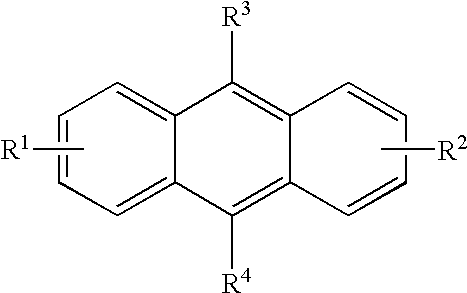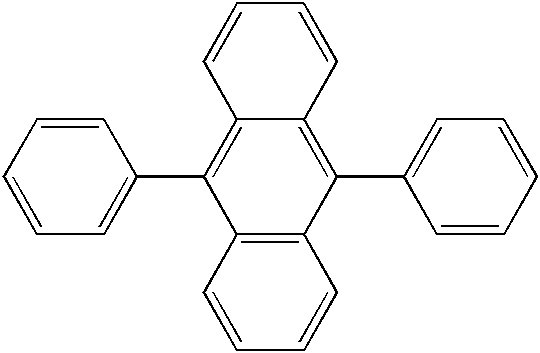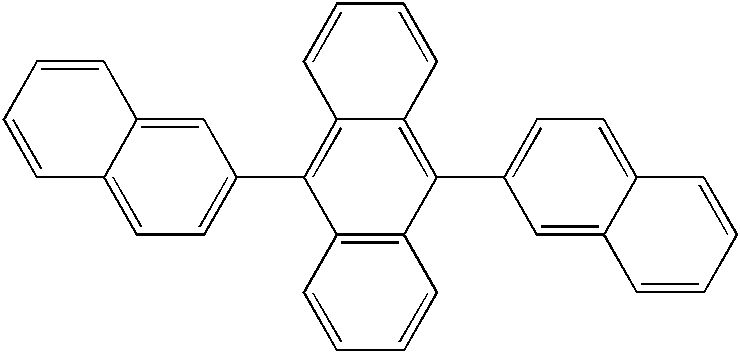Organic light emitting diode devices with improved luminance efficiency
a light-emitting diode and organic technology, applied in the direction of discharge tube luminescnet screens, other domestic articles, natural mineral layered products, etc., can solve the problems of drive current density persisting or el efficiency decreasing with increasing light output, and achieve excellent efficiency and chromaticity. excellent effect of luminance efficiency
- Summary
- Abstract
- Description
- Claims
- Application Information
AI Technical Summary
Benefits of technology
Problems solved by technology
Method used
Image
Examples
example 2
[0109] An OLED device similar to that of Comparative Example 1 was constructed, except that in the luminescent layer, TBADN is the material for the first host component, AlQ is the material for the second host component, and DCJTB is the fluorescent dopant. The relative amounts of TBADN, AlQ, and DCJTB on a volume basis are in the ratio 89:10:1. The EL characteristics of this device are also shown in Table I.
example 3-5
[0110] OLED devices similar to that of Example 2 were constructed, except that the relative amounts of TBADN, AlQ, and DCJTB in the luminescent layer are in the ratio 74:25:1 for Example 3, 49:50:1 for Example 4, and 25:74:1 for Example 5. The EL characteristics of these devices are also shown in Table I.
example 7-10
[0114] OLED devices similar to those of Examples 2-5 were constructed, except that the first host material is ADN. Again, the second host material is AlQ, and the fluorescent dopant is DCJTB. The composition of the luminescent layer and the EL characteristics of these devices are shown in Table II. Conclusions similar to those drawn for TBADN:AlQ in Examples 1-6 can be made for the ADN:AlQ mixed host.
2TABLE II Compositions and EL properties of OLED devices of Examples 7-10 First host Second host Dopant Current ADN A1Q DCJTB density Efficiency Drive Example Vol % Vol % Vol % (mA / cm.sup.2) (cd / A) CIEx CIEy voltage (V) 7 89 10 1 1 6.27 0.621 0.376 6.9 100 6.15 0.614 0.382 13.0 8 74 25 1 1 5.78 0.626 0.371 7.0 100 5.47 0.618 0.378 12.8 9 49 50 1 1 5.26 0.633 0.365 6.8 100 4.41 0.622 0.374 12.5 10 25 74 1 1 4.59 0.635 0.362 6.8 100 3.25 0.622 0.374 12.4
PUM
| Property | Measurement | Unit |
|---|---|---|
| dipole moment | aaaaa | aaaaa |
| dipole moment | aaaaa | aaaaa |
| dipole moment | aaaaa | aaaaa |
Abstract
Description
Claims
Application Information
 Login to View More
Login to View More - R&D
- Intellectual Property
- Life Sciences
- Materials
- Tech Scout
- Unparalleled Data Quality
- Higher Quality Content
- 60% Fewer Hallucinations
Browse by: Latest US Patents, China's latest patents, Technical Efficacy Thesaurus, Application Domain, Technology Topic, Popular Technical Reports.
© 2025 PatSnap. All rights reserved.Legal|Privacy policy|Modern Slavery Act Transparency Statement|Sitemap|About US| Contact US: help@patsnap.com



